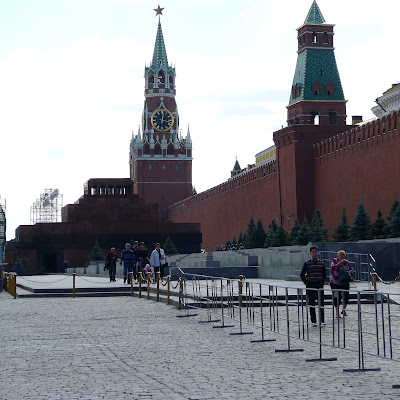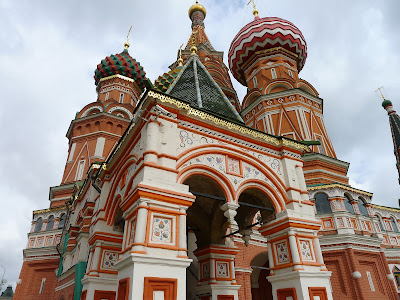 |
| The famous Mockba Route |
The Trans-Mongolian route travels through seven time zones and 7,865 miles to connect the two Great Capitols with Important Dead Guys in their Central Squares: Moscow and Beijing. Today, to finish the series, we are going to delve into the mysteries of "What Do You Do for Seven Days on a Train?"
So here we go! As we piled on to the train, we were surprised to be greeted on the Russian train by...Chinese train attendants. As it turns out, the staff of the Trans-Mongolian are Chinese.
Imagine that! To fly 8,000 kilometers from China to find....Chinese. We were chuckling to ourselves as we carried our own bags up the steep stairs and dragged them into the cabin. The staff of the other two routes, the Trans-Manchurian and Trans-Siberian, are Russian. The restaurant cars, which are changed as the train crosses into each country, are staffed by Russians, Mongolians and Chinese respectively, but the train staff were our old friends from the P.R.C. We felt quite at home when they threw our blankets and sheets at us, nodded noncommittally to our questions and generally expected us to live honorably and independently for the rest of the journey.
We here at the YRC do enjoy a life of romance and adventure. Usually. And we very much want to share the experience of the trip. So, to help the beloved YRC readership understand the fundamentals of day to day life on the Trans-Mongolian, we have added a new feature to the YRC, an Einsteinian Mind Experiment! GLHF!!
The Importance of Trans-Mongolian Relativity Theory:
So here we go! As we piled on to the train, we were surprised to be greeted on the Russian train by...Chinese train attendants. As it turns out, the staff of the Trans-Mongolian are Chinese.
Imagine that! To fly 8,000 kilometers from China to find....Chinese. We were chuckling to ourselves as we carried our own bags up the steep stairs and dragged them into the cabin. The staff of the other two routes, the Trans-Manchurian and Trans-Siberian, are Russian. The restaurant cars, which are changed as the train crosses into each country, are staffed by Russians, Mongolians and Chinese respectively, but the train staff were our old friends from the P.R.C. We felt quite at home when they threw our blankets and sheets at us, nodded noncommittally to our questions and generally expected us to live honorably and independently for the rest of the journey.
 |
| Hey, imagine seeing YOU here!! |
The Importance of Trans-Mongolian Relativity Theory:
Ready? Let us suppose that there is a Tovarich standing on a train platform and a Tovarich on a train. They are both wearing big fluffy hats and wave to each other cheerfully. Now, if the train starts rolling through the station at 10 kph, the Tovarich on the train will appear to the Tovarich on the platform to be traveling at 10 kph, yes? Yes. There goes Ivan, rolling by! See you, next week, Comrade!
 |
| Platform Tovarich and Train Tovarich at work |
 |
| Hurtling Through the First-Class Cabin |
So, inside the train he is traveling at 10kph, but outside he is traveling at 20 kph (his speed plus the train's speed). He moves away from Platform Tovarich at 20 kph, correct? Da!
Now, the third and final experiment. Let us imagine that the Tovarich on the train runs towards the back of the train at 10Kph. This means he stays exactly at the same place as the Tovarich on the platform even though the train is moving. This is just like walking the wrong way on an escalator. To the Platform Tovarich, the train is moving but his friend, the Train Tovarich, is not moving. To the Train Tovarich, he is moving at 10 kph but the Platform Tovarich is right there on the platform. This relative movement effect, dear readers, is at the heart of Trans-Mongolian relativity theory.
Why is any of this important, you may snarl as you spill your coffee on your banana pancakes. Where are the snacks, you may ask.
This is to illustrate what happens on the Trans-Mongolian, dear readers. You board in Moscow and leave near midnight. You fall asleep in your cozy bunk watching the lights flicker outside the window and listening to the gentle click-clack of the wheels. You dream of snow and wolves and Vladimir Ilyich Lenin in a bear suit. When you wake up the next morning, you are rolling past Chuklominsky, 910 km from Moscow. You feast on Russian oatmeal and tea made with smokey water from the Samovar and you check the fluid levels in the vodka bottles. All is good and the western Russian countryside is rolling by. You have your quiet little home rattling due east at a steady 57kph, headed to Udmurt country.
The days progress but you no longer measure in time. You measure in distance. How far are we away from Moscow? How far to the next platform packed with babushka with boiled potatoes with dill? And, beer?
 Then you have your moment of Trans-Mongolian Relativity. Due to the harmony and peace of traveling on a train (and also that there is not much else to do) you are actually having a zen moment. You are perfectly still. The steam from the tea cup rises before you. Beams of sunlight drift across the table top. You suddenly understand a fundamental truth: You are actually not moving. it is the countryside that is moving! And you settle in to watch 8,000 kilometers of spectacular scenery.
Then you have your moment of Trans-Mongolian Relativity. Due to the harmony and peace of traveling on a train (and also that there is not much else to do) you are actually having a zen moment. You are perfectly still. The steam from the tea cup rises before you. Beams of sunlight drift across the table top. You suddenly understand a fundamental truth: You are actually not moving. it is the countryside that is moving! And you settle in to watch 8,000 kilometers of spectacular scenery.
We here at the YRC are used to traveling long distances to arrive in places where our time is 12 hours out of sync with local time. In this case, we had traveled 8,000 kilometers away to return to time that was...the same...as our time?? By the time we got to Beijing, we had crossed seven time zones to end up back in the original time zone, creating some severe temporal issues, we will confess. We still occasionally check our watches to see how far we are from Beijing but that's one of the hazards of life in the fast lane.
 |
| Next stop, the Kyrgyz Steppes |
 |
| How many klicks to Ulan Bator? |
 Then you have your moment of Trans-Mongolian Relativity. Due to the harmony and peace of traveling on a train (and also that there is not much else to do) you are actually having a zen moment. You are perfectly still. The steam from the tea cup rises before you. Beams of sunlight drift across the table top. You suddenly understand a fundamental truth: You are actually not moving. it is the countryside that is moving! And you settle in to watch 8,000 kilometers of spectacular scenery.
Then you have your moment of Trans-Mongolian Relativity. Due to the harmony and peace of traveling on a train (and also that there is not much else to do) you are actually having a zen moment. You are perfectly still. The steam from the tea cup rises before you. Beams of sunlight drift across the table top. You suddenly understand a fundamental truth: You are actually not moving. it is the countryside that is moving! And you settle in to watch 8,000 kilometers of spectacular scenery.We here at the YRC are used to traveling long distances to arrive in places where our time is 12 hours out of sync with local time. In this case, we had traveled 8,000 kilometers away to return to time that was...the same...as our time?? By the time we got to Beijing, we had crossed seven time zones to end up back in the original time zone, creating some severe temporal issues, we will confess. We still occasionally check our watches to see how far we are from Beijing but that's one of the hazards of life in the fast lane.
And so, we're going to keep moving here at the YRC and head out to San Francisco, the Castro, and Napa Valley! Thanks for tuning in, and come back next week for the exciting "Wedding in Napa Valley!"

































